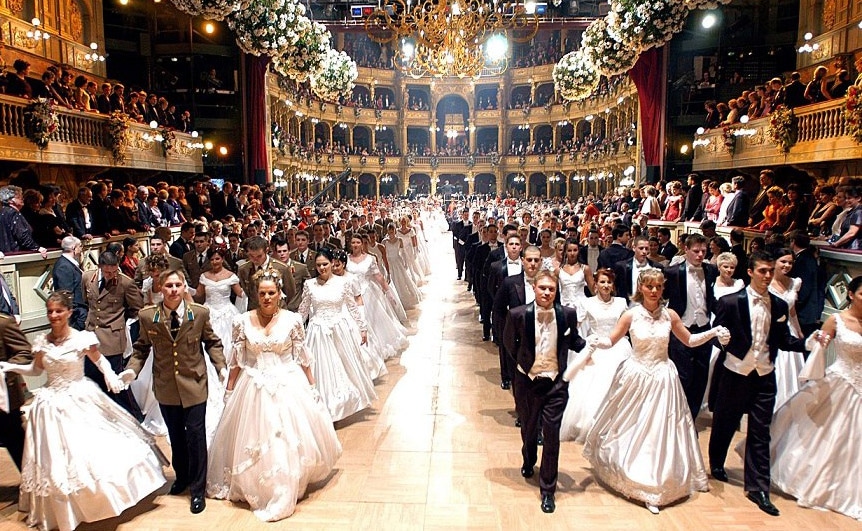
Baroque streetscapes and imperial palaces set the stage for Vienna’s artistic and musical masterpieces alongside its coffee-house culture and vibrant epicurean and design scenes.
“Vienna’s imperial grandeur is the legacy of the powerful Habsburg monarchy. Their home for more than six centuries, the Hofburg palace complex, incorporates the Burgkapelle (Imperial Chapel), where the Vienna Boys’ Choir sings Sunday Mass, and the famed Spanish Riding School, where Lipizzaner stallions perform elegant equine ballet, along with a trove of museums, including in the chandeliered Kaiserappartements (Imperial Apartments). Other immense palaces include the baroque Schloss Belvedere and the Habsburgs’ 1441-room summer residence, Schönbrunn, while 19th-century splendours such as the neo-Gothic Rathaus (City Hall) line the magnificent Ringstrasse encircling the Innere Stadt (inner city)”.
In the Museums Quartier district, historic and contemporary buildings display works by Egon Schiele, Gustav Klimt and other artists.
Austria’s Imperial capital offers a unique blend of imperial traditions and stunning modern architecture. It is famous for its cultural events, imperial sights, coffee houses, cozy wine taverns, and the very special Viennese charm.
- Wine Capital (1,700 acres of vineyards, 320 vintners e.g. Grüner Veltliner, Rheinriesling and Weißburgunder). 640 wine framers in Vienna produce 2.5 million liters wine every year. Grapes were cultivated in Vienna as early as 1132 A.D. The Heurigen (wine taverns) scene was made possible through an imperial edict, which allowed growers to serve food with their wine.
- Viennese heuriger culture (wine taverns) has also been considered an intangible cultural heritage by UNESCO.
- City of Music, or the World’s Capital of Music, as more famous composers have lived here than in any other city in the world (Wolfgang Amadeus Mozart, Ludwig van Beethoven, Joseph Haydn, Franz Schubert, Johann Straus and Johannes Brahms are just a few who called Vienna home). While in Vienna, you can visit the former apartments of many of these famous musicians, which have been turned into museums. And don’t miss The House of Music. Here you can “discover the fascinating world of sound and Viennese music in an interactive, playful way”.
- City of Dreams: Sigmund Freud, the father of psychoanalysis, lived and worked for nearly 50 years.
- Tiergarten Schönbrunn or the Vienna Zoo, built in the Palace’s gardens in 1752, is considered the world’s most beautiful zoo and boasts over 700 different animal species. And it is said to be the oldest zoological garden in the world.
- Vienna is divided into 23 districts. The city center in Vienna is a World Heritage Site.
- The Austrian flag is one of the oldest national flags in the world.
- Austrian Croissants: The famous French croissant has Viennese origin, the Austrian kipferl (i.e. crescent in German). Bakers in Vienna made kipferl to commemorate Austria’s victory over the Ottoman Turks. The shape is based on the crescents seen on the uniform of the enemy. It is in 1770, when Maria Antoinette of Austria who married King Louis XVI of France, introduced her favorite pastry to France.
- The Wiener Riesenrad is the oldest still operating ferris wheel in the world.
- Vienna’s Central Cemetery (Zentralfriedhof) has over 2.5 million tombs (more than the city’s live population), including those of Beethoven, Brahms, Gluck, Schubert, Schoenberg and Strauss.
- The Sacher Torte was made by Franz Sacher, when the chef of the court of Prince Metternich fallen ill – just on when the prince ordered a new dessert. So the 16-year-old trainee, Franz Sacher, created a new dish. Hence, on that day in 1832, the Sacher Torte was born.
- The candy Pez, was invented in Vienna in 1927. Pez is the abbreviation of the German word “pfefferminz” or peppermint. The dispenser design looked like a lighter. Smoking was prohibited, so the Pez slogan was “No Smoking – PEZing Allowed.”
- The snow globe was also invented in Vienna, in 1900. The inventor, Erwin Perzy and his brother, are still making traditional snow globes, all hand painted and manually assembled.
- Vienna has been voted the world’s most livable city for the last 7 years in a row.
- Like Berlin, Vienna was also divided into four parts after WWII.
- More than 300 Balls are held annually in Vienna (Covid-era excluded)
- Viennese coffee culture is part of UNESCO intangible Cultural Heritage. (Café Prückel, has more than 100 years under its belt; Kaffee Alt Wien; Café Central housed inside Palais Ferstel; Café Diglas welcomed Emperor Franz Joseph I as his very first guest; Café Schwarzenberg; Cafe Museum; …)
- Vienna sits on the border of 2 climate zones: the European transitional climate and the dry Pannonian zone.
- Vienna the eco-friendly city: In 2014, Vienna adopted a ‘Smart City’ policy, which aims to have 50% of the city’s energy consumption come from renewable sources; and must limit the overall carbon emissions by 2050.
| VIENNA: SOME SITES TO SEE | ||||
| Schönbrunn Palace
and Tiergarten Schönbrunn |
St. Peter’s Catholic Church | Albertina Museum | MuseumsQuartier | Stephansplatz |
| The Hofburg | Rathaus | Leopold Museum | Vienna State Opera | Maria-Theresien-Platz |
| Imperial Treasury Vienna (Hofburg Palace) | Viennese Giant Ferris Wheel | Kunsthistorisches Museum Wien | Seegrotte | Karlsplatz |
| Belvedere Palace | Prater
|
Museum of Natural History Vienna | Column of Pest (Column of The Trinity) | Heldenplatz |
| St. Stephen’s Cathedral | Spanish Riding School | Sigmund Freud Museum | Historic Centre of Vienna | Rathausplatz |
| Karlskirche | Austrian National Library | Austrian Parliament Building | Castle Liechtenstein | Mariahilferstrasse |
| Church of St. Charles Borromeo (Imperial Court Palace) | Neue Berg | Salzburg (317Km, 3H25)
|
Danube Valley
|
Ringstrasse |
